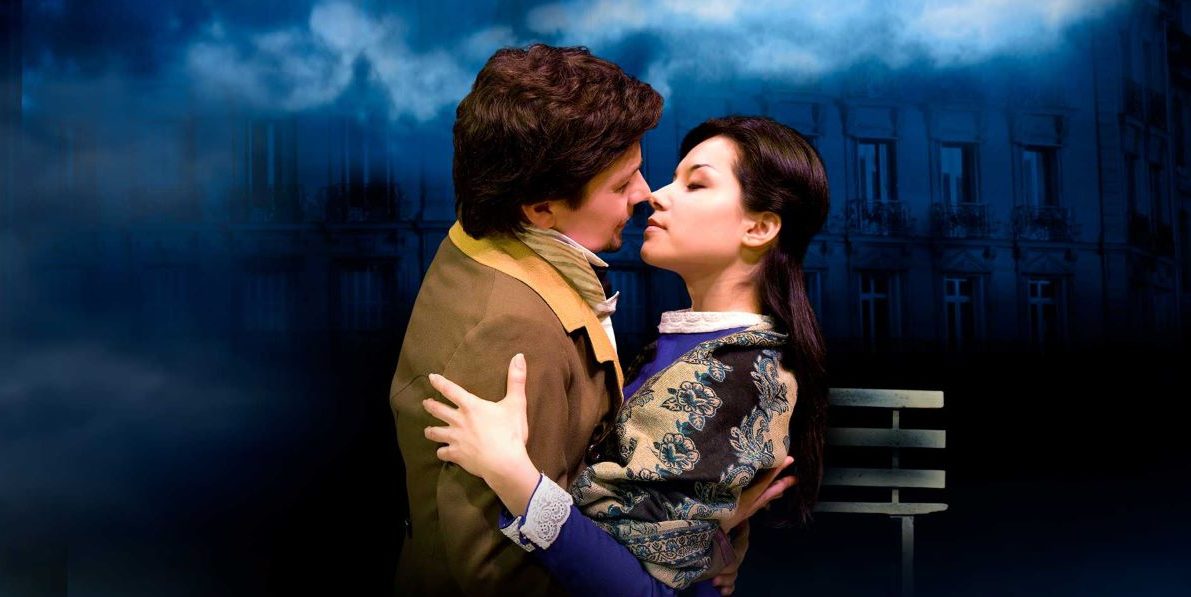The WNO is touring a La Bohème that gets most things about the opera right.
The production by Annabel Arden revived by Caroline Chaney is traditional, direct and simple, does nothing to grate, and is therefore excellent at letting the story and the characters come through. The design by Stephen Brimson Lewis works really well, conveys the setting of each scene clearly, and is never cluttered or intrusive. The costumes help set the opera in the period in which it was written. Tim Mitchell’s lighting complements the design and creates just the right mood for each scene, especially memorably at the Barrière d’Enfer in the third scene. And I must make a special mention of the fine work of the chorus in the second and third scenes before proceeding.
The first half, with the students in their impoverished garret, is energetic and good humoured. The second half, with Mimi’s developing illness, the breakup of Marcello and Musetta, and Mimi’s final collapse, unfolds with feeling and a strong sense of drama. The show is being used to highlight several singers and the cast that I saw fielded silvery-voiced Angharad Morgan as Mimi, I believe as a last minute substitute. She is a student of the wonderful Nuccia Focile and this is evident in her poised dramatic singing and demeanour. Luis Gomes is a very appealing Rudolfo with some great high notes, Aoife Miskelly is sparkling and exciting as Musetta and Germán E Alcantára is a gruff, solid-voiced Marcello who presented this character with emphasis on the darkness in the soul at times. All the cast were up to the demands of their parts vocally and histrionically, and Angharad Morgan’s Mimì seemed to me to have an exceptionally lovely timbre to her voice and some wonderful, high floating notes as well as the requisite charm for her character. Her “Mi chiamano Mimì” was one of her many gorgeous moments. Musetta is, as Musetta always is, a standout, a heart-of-gold hoyden with a vivid voice who totally takes over the stage with her big moment in the Café Momus scene.
Above all the glory of this performance is the WNO chorus and orchestra led brilliantly by the conductor Pietro Rizzo. I was hearing his work for the first time and I would happily attend anything I can that he is conducting from now on. Over and over again there were moments in the music where he brought out details with such astonishing clarity that I was hearing those passages afresh. Slowing down his tempi sometimes for the sake of giving the singers extra space to register their emotions, the poignancy and romanticism of the score is conveyed beautifully. His pacing of the entire score was exemplary and his sense of its architecture and varying moods complete. He seemed also, to me, to have complete contact with everyone on the stage as well as everyone in the pit.
David Shipley as Colline and Mark Nathan as a rubber limbed Schaunard were dramatically cogent and memorable and vocally appealing. I thought that the Café Momus scene was handled with particular panache and I was especially captivated and moved by the scene at the Gate d’Enfers.
A performance that was always moving forward and yet focused on detail, this was a very fine way to experience this work. I have seen La Boheme many times, sometimes with very famous singers, but this was a special and moving performance that will stay with me. It is typical of the Welsh National Opera in its ability to gather together fine musicians and creatives working as a team for a presentation not of star moments only but of the work itself, the work entire. All the big moments stood out, partly because the singers knew what to do, but also because the conductor had a real grasp of all the beauties and nuances of this wonderful score. Pietro Rizzo’s overall control was the keystone of the evening.

